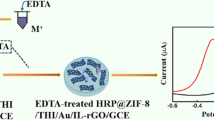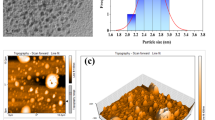Abstract
An electrochemical sensor for Pb(II) is described that exploits (a) the outstanding adsorption ability of chitosan modified with quaternary ammonium groups (CQAS; cationic) and of lignosulfonate (LSN; anionic), and (b) the good electrical conductivity of polypyrrole nanoparticles (PPy NPs). A glassy carbon electrode (GCE) was modified with PPy NPs and polydopamine, and CQAS and LSN are used as dispersants in PPy. The modified GCE exhibits high selectivity and sensitivity for Pb(II) in the 0.1 to 50 μM concentration range, with a 55 nM detection limit (3σ method). The redox potentials for Pb(II) is around −0.55 V, and the sensor is not interfered by the presence of Hg(II) and Cu(II). The time dependent stability test showed that this sensor can maintain good reproducibility for one month. This sensor was applied to the determination of Pb(II) in wastewater samples.

An electrochemical sensor for lead(II) is described that exploits the outstanding adsorption ability of chitosan that carries quaternary ammonium groups (CQAS), of lignosulfonate (LSN), and the good electrical conductivity of polypyrrole nanoparticles. CQAS and LSN are used as dispersants in PPy. The sensor exhibits high selectivity and sensitivity for Pb(II) in the range of 0.1 to 50 μM with a 55 nM detection limit.






Similar content being viewed by others
References
Han W, Gao GH, Geng JY, Li Y, Wang YY (2018) Ecological and health risks assessment and spatial distribution of residual heavy metals in the soil of an e-waste circular economy park in Tianjin, China. Chemosphere 197:325–335
Saha P, Paul B (2019) Assessment of heavy metal toxicity related with human health risk in the surface water of an industrialized area by a novel technique. Hum Ecol Risk Assess 25:966–987
Rocha A, Trujillo KA (2019) Neurotoxicity of low-leval lead exposure: history, mechanisms of action, and behavioral effects in humans and preclinical models. Neurotoxicology 73:58–80
Ecke F, Singh NJ, Arnemo JM, Bignert A, Helander B, Berglund ÅMM, Borg H, Bröjer C, Holm K, Lanzone M, Miller T, Nordström Å, Räikkönen J, Rodushkin L, Ågren E, Hörnfeldt B (2017) Sublethal lead exposure alters movement behavior in free-ranging golden eagles. Environ Sci Technol 51:5729–5736
Dos SJM, Quináia SP, Felsner ML (2018) Fast and direct analysis of Cr, cd and Pb in brown sugar by GF AAS. Food Chem 260:19–26
O’Neil GD, Newton ME, Macpherson JV (2015) Direct identification and analysis of heavy metals in solution (Hg, Cu, Pb, Zn, Ni) by use of in situ electrochemical X-ray fluorescence. Anal Chem 87:4933–4940
Yang YL, You Y, Liu YC, Yang ZS (2013) A lead(II) sensor based on a glassy carbon electrode modified with Fe3O4 nanospheres and carbon nanotubes. Microchim Acta 180:379–385
Dai PP, Yang ZS (2012) Sensor for lead(II) ion based on a glassy carbon electrode modified with double-stranded DNA and ferric oxide nanoparticles. Microchim Acta 176:109–115
Saidur MR, Aziz ARA, Basirun WJ (2017) Recent advances in DNA-based electrochemical biosensors for heavy metal ion detection: a review. Biosens Bioelectron 90:125–139
Zuo YX, Xu JK, Zhu XF, Duan XM, Lu LM, Yu YF (2019) Graphene-derived nanomaterials as recognition elements for electrochemical determination of heavy metal ions: a review. Microchim Acta 186:171
Ding JN, Zhang DW, Liu Y, Yu ML, Zhan XJ, Zhang D, Zhou P (2019) An electrochemical aptasensor for detection of lead ions using a screen-printed carbon electrode modified with au/polypyrrole composites and toluidine blue. Anal Methods 11:4274
Teng Y, Liu F, Kan XW (2017) Voltammetric dopamine sensor based on three-dimensional electrosynthesized molecularly imprinted polymers and polypyrrole nanowires. Microchim Acta 184:2515–2522
Mollahosseini A, Khadir A, Saeidian J (2019) Core-shell polypyrrole/Fe3O4 nanocomposite as sorbent for magnetic dispersive solid-phase extraction of Al3+ ions from solutions: investigation of the operational parameters. J Water Process Eng 29:100795
Zhou C, Zhu H, Wang Q, Wang JX, Cheng J, Guo YF, Zhou XJ, Bai RB (2017) Adsorption of mercury(II) with an Fe3O4 magnetic polypyrrole–graphene oxide nanocomposite. RSC Adv 7:18466–18479
Ouyang XP, Deng YH, Qian Y, Zhang P, Qiu XQ (2011) Adsorption characteristics of lignosulfonates in salt-free and salt-added aqueous solutions. Biomacromolecules 12:3313–3320
Phan DN, Lee H, Huang BJ, Mukai Y, Kim IS (2019) Fabrication of electrospun chitosan/cellulose nanofibers having adsorption property with enhanced mechanical property. Cellulose 26:1781–1793
Li MX, Feng QM, Zhou Z, Zhao W, Xu JJ, Chen HY (2018) Plasmon-enhanced electrochemiluminescence for nucleic acid detection based on gold nanodendrites. Anal Chem 90:1340–1347
Xu TT, Chi B, Chu ML, Zhang QC, Zhan SY, Shi RJ, Xu H (2018) Hemocompatible ɛ-polylysine-heparin microparticles: a platform for detecting triglycerides in whole blood. Biosens Bioelectron 99:571–577
Singh D, Choudhary A, Garg A (2018) Flexible and robust piezoelectric polymer nanocomposites based energy harvesters. ACS Appl Mater Interfaces 10:2793–2800
Lizundiaa E, Urruchi A, Vilas JL, Leóna LM (2016) Increased functional properties and thermal stability of flexible cellulose nanocrystal/ZnO films. Carbohydr Polym 136:250–258
Qian LJ, Ye LJ, Qiu Y, Qu SR (2011) Thermal degradation behavior of the compound containing phosphaphenanthrene and phosphazene groups and its flame retardant mechanism on epoxy resin. Polymer 52:5486–5493
Yang D, Liu H, Wang DL, Luo ZJ, Lu Y, Xia F, Liu Y (2018) Co-catalysis over a bi-functional ligand-based Pd-catalyst for tandem bis-alkoxycarbonylation of terminal alkynes. Green Chem 20:2588–2595
Cao NN, Wang XB, Song LY, Zhang ZC (2007) Nanopore microspheres prepared by a cationic surfmer in the miniemulsion polymerization of styrene. J Polym Sci A Polym Chem 45:5800–5810
Harpale K, More M, Koinkar P, Paill SS, Sonawane KM (2015) Polypyrrole nanostructures and their field emission investigations. Mod Phys Lett B 29:1540035–1540039
Foo CY, Huang NM, Lim HN, Jiang ZT, Altarawneh M (2019) Hydrostatic bath synthesis of conductive polypyrrole/reduced graphene oxide aerogel as compression sensor. Eur Polym J 117:227–235
Beluomin MA, Silva JLD, Sedenho GC, Stradiotto NR (2017) D-mannitol sensor based on molecularly imprinted polymer on electrode modified with reduced graphene oxide decorated with gold nanoparticles. Talanta 165:231–239
Shervedani RK, Amini A (2015) Preparation of graphene/nile blue nanocomposite: application for oxygen reduction reaction and biosensing. Electrochim Acta 173:354–363
Liu XY, Venkatraman K, Akolkar R (2018) Communication-electrochemical sensor concept for the detection of lead contamination in water utilizing lead underpotential deposition. J Electrochem Soc 165:B9–B11
Dai L, Li YY, Wang YG, Luo XL, Wei D, Feng R, Yan T, Ren X, Du B, Wei Q (2019) A prostate-specific antigen electrochemical immunosensor based on Pd NPs functionalized electroactive Co-MOF signal amplification strategy. Biosens Bioelectron 132:97–104
Li ZJ, Yin JF, Gao CH, Qiu GH, Meng AA, Li QD (2019) The construction of electrochemical aptasensor based on coral-like polyaniline and au nano-particles for the sensitive detection of prostate specific antigen. Sensor Actuat B-Chem 295:93–100
Hwang JH, Pathak P, Wang XC, Rodriguez KL, Park J, Cho HJ, Lee WH (2019) A novel Fe-chitosan-coated carbon electrode sensor for in situ As(Ш) detection in mining wastewater and soil leachate. Sensor Actuat B-Chem 294:89–97
Lin XN, Lu ZW, Zhang YX, Liu BC, Mo GQ, Li JY, Ye JS (2018) A glassy carbon electrode modified with a bismuth film and laser etched graphene for simultaneous voltammetric sensing of Cd(II) and Pb(II). Microchim Acta 185:438
Abdulla M, Ali A, Jamal R, Bakri T, Wu W, Abdiryim T (2019) Electrochemical sensor of double-thiol linked PProDOT@Si composite for simultaneous detection of Cd(II), Pb(II), and Hg(II). Polymers 11:815
Sun YF, Jian W, Li PH, Yang M, Huang XJ (2019) Highly sensitive electrochemical detection of Pb(II) based on excellent adsorption and surface Ni(II)/Ni(III) cycle of porous flower-like NiO/rGO nanocomposite. Sensor Actuat B-Chem 292:136–147
Acknowledgements
This work was supported by the National Natural Science Foundation of China (31730106) and Nanjing Forestry University 2018 Scientific Research Start-up Funds (163105042).
Author information
Authors and Affiliations
Corresponding author
Additional information
Publisher’s note
Springer Nature remains neutral with regard to jurisdictional claims in published maps and institutional affiliations.
Electronic supplementary material
ESM 1
(DOCX 698 kb)
Rights and permissions
About this article
Cite this article
Xu, T., Dai, H. & Jin, Y. Electrochemical sensing of lead(II) by differential pulse voltammetry using conductive polypyrrole nanoparticles. Microchim Acta 187, 23 (2020). https://doi.org/10.1007/s00604-019-4027-z
Received:
Accepted:
Published:
DOI: https://doi.org/10.1007/s00604-019-4027-z




